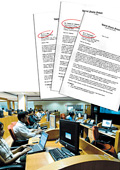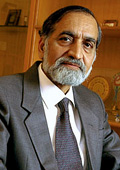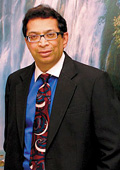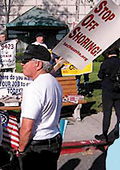 |
| You've got mail: Infosys got the most
H-1Bs last year |
On
may 14, as executives at TCS, Infosys and Wipro's US offices-in
Arlington, Virginia; Fremont and Mountainview, California, respectively-were
just getting over their Monday morning blues, something arrived
in their mail rooms that deepened their funk. It was a letter
from Senators Charles E. Grassley and Richard J. Durbin wanting
to know how these companies-besides Satyam Computer Services,
MphasiS Corp., Patni Computer Systems, L&T Infotech, Tech
Mahindra, and i-flex-were utilising their H-1B visa workers. More
specifically, the two-page letter sought details across four areas:
Number of H-1B visas sought and how they were used; average wage
of H-1B visa holders; body shopping of H-1B workers; layoffs in
the US, and if any of those laid off were replaced by H-1B workers.
In all, 21 different questions. "We appreciate your cooperation,
and respectfully request that you respond to our questions no
later than May 29, 2007," the Senators wrote.
The deadline expired a day after BT went
to press, but until the 28th, none of the nine companies-BT contacted
all-was willing to comment on the issue. Hardly surprising. The
issue is highly inflammatory in the US, which is debating a new
bill on immigration that will allow many of its 12 million illegal
immigrants (mainly Mexicans) to reside legally, and also increase
the number of work visas granted to foreign workers from 65,000
to 115,000 a year. While President George Bush has called the
bill historic for what it seeks to achieve, opinion is divided
among other Americans, including Senators, immigration experts,
think-tanks, high-tech companies, and people at large.
 |
| Home Comfort: TCS is India's biggest
IT firm but has fewer H-1BS |
The US Senate, which debated the bill the
third week of May, will reconvene early June to take up the issue
once more. But before going on a recess, the Senate did manage
to get decisions made on some key issues. On May 24, it voted
in favour of a decision to increase fees imposed on employers
who hire H-1B workers. The money will be used to fund scholarships
in healthcare and the sciences (including computer science) for
American citizens. Thanks to Senator Edward Kennedy, an amendment
that would have ended H-1B visas for less-skilled workers starting
2012, was narrowly defeated. There were 48 votes for it, and only
49 against it.
Critics of the bill-at least, the part that
pertains to temporary work visas-say that the proposed rules are
cumbersome and unrealistic. For instance, employers hiring foreign
workers may now have to prove that not only is the skill in question
not available in the US, but also that it will not lead to displacement
of any American workers. That means an IBM or a Microsoft may
simply decide to expand their development centres outside of the
US than go through an expensive, messy and time-consuming process
of justifying H-1B hires. Neither Grassley nor Durbin, who are
championing a review of H-1Bs, replied to BT's e-mailed questionnaire,
but Beth Levine, a spokesperson for Grassley, did e-mail BT a
statement that said, "Senator Grassley is in favour of increasing
legal immigration avenues. But his questions to the Indian companies
are an effort to gather more information because of allegations
of fraud and abuse within the H-1B visa program."
Mum is the Word
 |
 |
NASSCOM's stand is that
work permits and intra-company transfers are issues related
to trade, not immigration
Kiran Karnik
President/
NASSCOM |
"Immigration and temporary
movement of skilled workers are two different issues, but
are unfortunately getting mixed up"
Arun Vakil
Immigration consultant |
The Indian it industry, meanwhile, has simply
decided to hunker down and let the storm blow over. For good reason.
It has been growing at a compounded annual growth rate (CAGR)
of 33 per cent over the last four years, with the top players
growing their revenues and profits at faster rates. Joining issue
with the ongoing debate may only roil the waters further, and
put the spotlight on the top it companies. Therefore, the industry
doesn't want to say or do anything that could affect its dream
run in a country that fetches more than half of its revenues.
However, the industry association, NASSCOM,
did issue a statement on May 15 that was meant to convey its members'
sentiment. "The Indian it industry and NASSCOM do not see
this as an immigration-related issue, but one related to international
trade, and would urge that work permits and intra-company transfers
(l-1 visas) not be intermingled and confused with immigration.
Work permits are primarily a tool for facilitating trade and allow
global companies to bring key staff to the US on temporary assignments,
just as US staff often travel across the world (on) temporary
assignments and this is clearly different from immigration,"
the Delhi-based agency said in a statement.
India's Union Commerce Minister Kamal Nath,
meanwhile, has expressed surprise that the Senators decided to
write directly to the companies instead of raising the issue through
proper channels or at an appropriate forum. "Temporary movement
of skilled professionals is an essential component of the global
services economy and bears no relation to immigration rules,"
Nath has been quoted as saying. "Unless we see forward movement
in such areas, it will be difficult for India to enhance its commitments
in the services negotiations," the minister has said, (possibly
much to the industry's horror) in what can be construed as a veiled
threat to American trade negotiators.
 |
| My job's gone: Critics say the visas
are unfair to Americans |
A Contentious Issue
As far as the H-1B part of the debate is
concerned, there are two primary concerns that some policymakers
have. One, that cheaper workers are displacing Americans and,
two, that they are depressing local wages. For instance, Ronil
Hira, assistant professor of public policy at the Rochester Institute
of Technology, and author of Outsourcing America: What's Behind
our National Crisis and How We Can Reclaim American Jobs, says
that Microsoft's Bill Gates has created the impression that all
H-1B workers earn $100,000 (Rs 41 lakh) a year, simply because
that's how much the software giant claims to pay them. The reality,
says Hira, who's also the Vice President of Career Activities
for IEEE and, hence, very interested in furthering the study of
electronics and electrical engineering in the US, is that the
median wage for new H-1B computer professionals is just $50,000
(Rs 20.50 lakh). "That means half earn less than $50,000.
This is less than the starting salary for a freshly-minted Bachelors
holder in Computer Science," says Hira, a second generation
Indian immigrant.
Other critics such as B. Lindsay Lowell,
Director of Policy Studies, Institute for the Study of International
Migration, Georgetown University, say that part of the wage difference
is "due to the lack of easy portability between employers,
which means that (the workers) can't negotiate a higher wage for
new employment opportunities." But he adds that "there
is also a small segment of employers that employs H-1Bs particularly
because they know they can get away with paying them less or working
them more."
While it's a fact that H-1B workers, and
not just those employed in it or with Indian companies, tend to
make less than their American peers, what must not be forgotten-at
least in the case of Indian it companies-is that such temporary
workers often continue to receive their rupee salaries back home,
besides other benefits, on top of their dollar salaries. Is that
unfair to American workers? Perhaps, but that's a consequence
of free and integrated world trade. Says Arun Vakil, a Mumbai-based
immigration consultant and author of Gateway to America: "Immigration
and temporary movement of skilled workers are two different issues,
but are unfortunately getting mixed up."
 |
 |
| The H-1B protagonists: Senators
Grassley (L) and Durbin suspect that Indian IT companies are
misusing H-1B visas and suppressing wages |
The argument that H-1B workers are displacing
American workers also seems exaggerated. A study put out recently
by Virginia-based National Foundation for American Policy, and
reported by the Washington Post, reveals that new H-1B visa workers
made up 0.07 per cent of the total American workforce in 2006
and that 57 per cent of them had advanced degrees. The study also
points out that "there is little evidence native information
technology (it) workers are harmed by the entry of H-1B professionals."
In fact, citing a study by Madeline Zavodny, a research economist
at the Federal Reserve Bank of Atlanta, the study says, "None
of the results suggests that an influx of H-1Bs lowers contemporaneous
average earnings. Indeed, many of the results indicate a positive,
statistically significant relationship."
The study further points out that "the
current low unemployment rate of 2.8 per cent in the category
of programmers means fewer than an estimated 17,000 computer programmers
nationwide are unemployed, with the vast majority facing 'frictional'
unemployment, simply between jobs, or located in the wrong geographic
area or possessing the wrong skill set. There is no evidence this
rate would be lower even if the US stopped the entry of all H-1B
professionals".
It's not the first time that the US is debating
its approach to immigration or that workers affected by the changing
dynamics of world trade are venting their feelings. But the problem
is, as Lowell puts it, "the very large 12 million illegal
residents who take up all the air in the room and squeeze out
meaningful discussion about highly-skilled visa classes".
One thing is for sure: Almost every company and policymaker understands
that shutting the doors to skilled workers would tantamount to
shipping out skilled work for good. That's a bargain the world's
largest economy won't seek.
|











